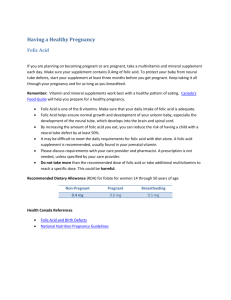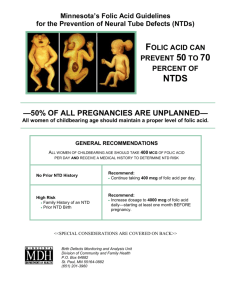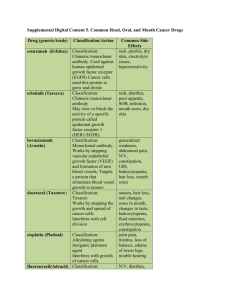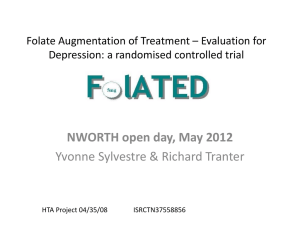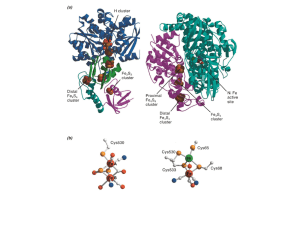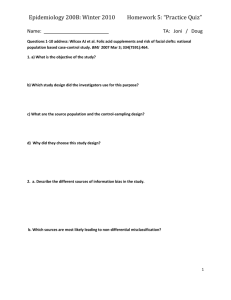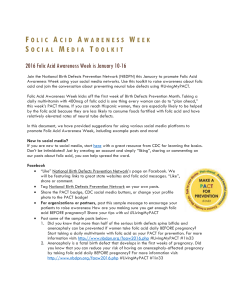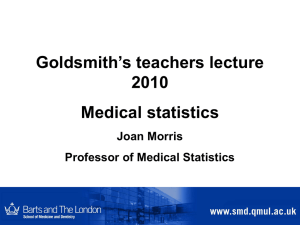Folic Acid
advertisement
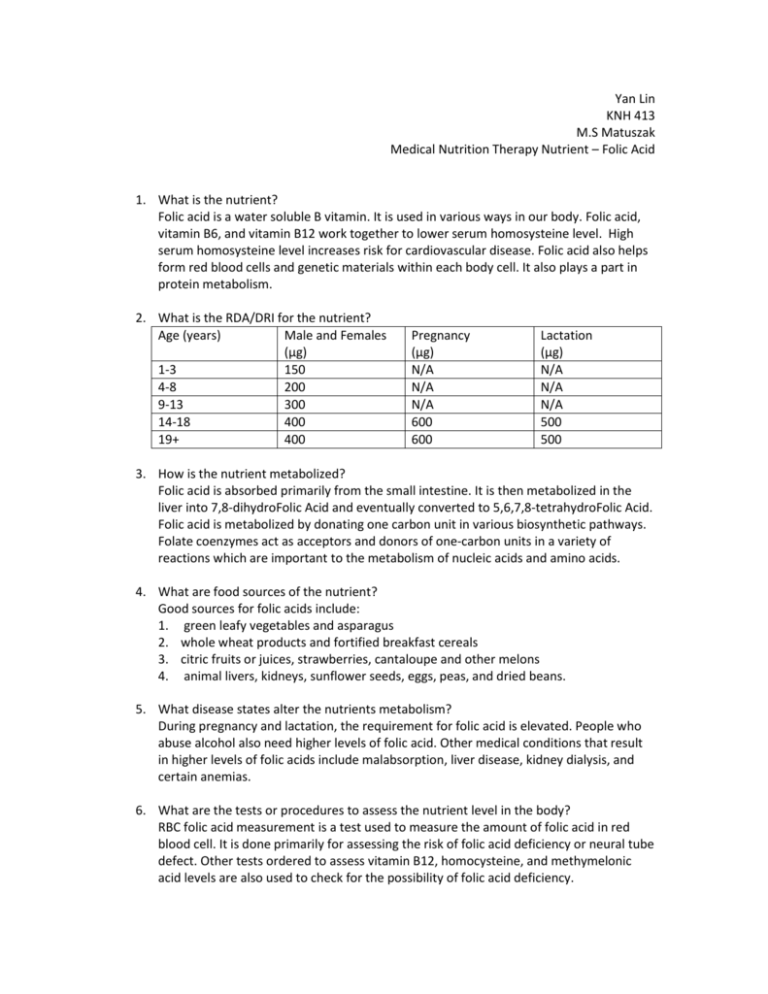
Yan Lin KNH 413 M.S Matuszak Medical Nutrition Therapy Nutrient – Folic Acid 1. What is the nutrient? Folic acid is a water soluble B vitamin. It is used in various ways in our body. Folic acid, vitamin B6, and vitamin B12 work together to lower serum homosysteine level. High serum homosysteine level increases risk for cardiovascular disease. Folic acid also helps form red blood cells and genetic materials within each body cell. It also plays a part in protein metabolism. 2. What is the RDA/DRI for the nutrient? Age (years) Male and Females (μg) 1-3 150 4-8 200 9-13 300 14-18 400 19+ 400 Pregnancy (μg) N/A N/A N/A 600 600 Lactation (μg) N/A N/A N/A 500 500 3. How is the nutrient metabolized? Folic acid is absorbed primarily from the small intestine. It is then metabolized in the liver into 7,8-dihydroFolic Acid and eventually converted to 5,6,7,8-tetrahydroFolic Acid. Folic acid is metabolized by donating one carbon unit in various biosynthetic pathways. Folate coenzymes act as acceptors and donors of one-carbon units in a variety of reactions which are important to the metabolism of nucleic acids and amino acids. 4. What are food sources of the nutrient? Good sources for folic acids include: 1. green leafy vegetables and asparagus 2. whole wheat products and fortified breakfast cereals 3. citric fruits or juices, strawberries, cantaloupe and other melons 4. animal livers, kidneys, sunflower seeds, eggs, peas, and dried beans. 5. What disease states alter the nutrients metabolism? During pregnancy and lactation, the requirement for folic acid is elevated. People who abuse alcohol also need higher levels of folic acid. Other medical conditions that result in higher levels of folic acids include malabsorption, liver disease, kidney dialysis, and certain anemias. 6. What are the tests or procedures to assess the nutrient level in the body? RBC folic acid measurement is a test used to measure the amount of folic acid in red blood cell. It is done primarily for assessing the risk of folic acid deficiency or neural tube defect. Other tests ordered to assess vitamin B12, homocysteine, and methymelonic acid levels are also used to check for the possibility of folic acid deficiency. 7. What is the drug - nutrient interactions? Medications that interfere with folic acid utilization include anticonvulsant medications, metformin (controlling blood sugar in type-2 diabetes), sulfasalazin, triamteren, methotrexate, and barbeturates. When taking these medications, the total intake of folic acid needs to be increased. 8. How is the nutrient measured? RBC folic acid measurement can be ordered along with vitamin B12, homocysteine, and methymelonic acid tests to assess the folic acid status in the body. The normal range for children 2-6 is >160ng/mL, for adolescent older than 16 is 140-628ng/mL, and for adults is 150-450ng/mL. 9. What is the Upper Tolerable Limits? Age Male and Females (years) (μg) 1-3 300 4-8 400 9-13 600 14-18 800 19+ 1000 Pregnancy (μg) N/A N/A N/A 800 1000 Lactation (μg) N/A N/a N/A 800 1000 10. What are the physical signs of deficiency? The physical signs of deficiency include neural tubal defect in infants, slow growing rate in infants and children, and folate deficiency anemia in adults. Others include diarrhea, loss of appetite, fatigue, weakness, high level of blood homocysteine, and etc. 11. What are physical signs of toxicity? Too much folic acid from dietary source would not cause any health concern, however, low toxicity would result from too much folic acid supplementation or folic acid fortified foods intake. Excess folic acid intake will be excreted in urine. However, research indicated that excess folic acid consumption was associated with vitamin B12 deficiency anemia which resulted in large red blood cells. References: 1. Office of Dietary Supplement. Folate. Retrieved from http://ods.od.nih.gov/factsheets/folate/ 2. The Ohio State University. Folate. Retrieved from http://ohioline.osu.edu/hygfact/5000/5553.html 3. Oregon State University. (2007). Folic acid. Retrieved from http://lpi.oregonstate.edu/infocenter/vitamins/fa/ 4. Marinus, M.G. Folic acid metabolism. Retrieved from http://users.umassmed.edu/martin.marinus/Mph200/FolicAcidMetabolism.pdf 5. University of Maryland Medical Center. (2011). Folic acid. Retrieved from http://www.umm.edu/altmed/articles/vitamin-b9-000338.htm 6. Medical Center of South Carolina. Folic acid measurement, RBC. Retrieved from http://www.muschealth.com/lab/content.aspx?id=150003 7. Lab Tests Online. Vitamin B12 and folic acid. Retrieved from http://labtestsonline.org/understanding/analytes/vitamin-b12/tab/test 8. Klee, G., G., Cobalamin and folate evaluation: measurement of methylmalonic acid and homocysteine vs vitamin B12 and folate, retrieved from Clinical Chemistry at http://www.clinchem.org/content/46/8/1277.full
